That’s right: These flowers not only shrug off clay soil, but they’ll even thank you for it too. These native perennials
, primarily found east of the Rockies, will come back every year. Collectively, this group provides flowers all summer, and several plants host various butterflies and moths. So whether you have dry or moist clay, you’ll find something to use in your region.
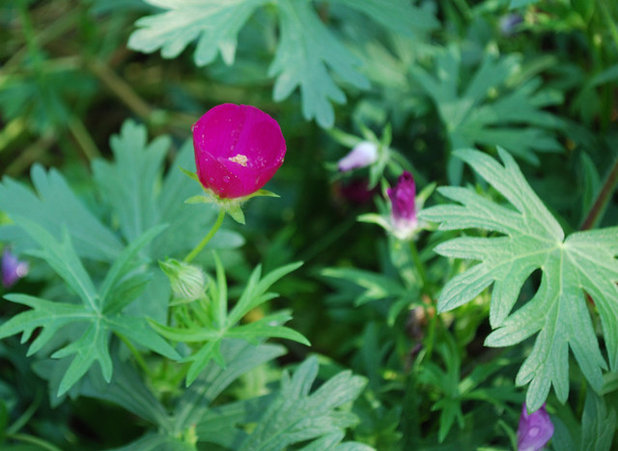
Jocelyn H. Chilvers
1. Purple Poppy Mallow(
Callirhoe involucrata)
Many of us need a ground cover that can take dry, hot, sunny punishment and keep pushing out flowers all summer long. Purple poppy mallow has a taproot, which comes in handy when bringing up energy stores to create new leaves. Unfortunately, rabbits enjoy eating it.
Where it will grow: Hardy to minus 30 degrees Fahrenheit, or minus 34.4 degrees Celsius (USDA zones 4 to 9; find your zone)
Origin: Native from Illinois to Wyoming south from Louisiana to eastern Arizona
Water requirement: Low to moderate
Light requirement: Full sun to partial shade
Mature size: 6 to 12 inches tall and 2 to 3 feet wide
See how to grow purple poppy mallow
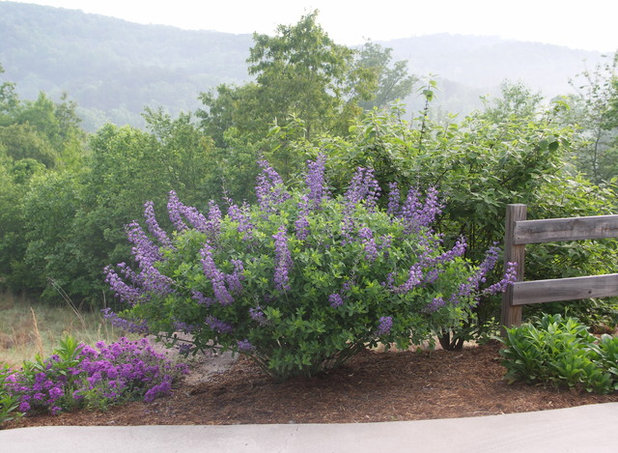
Earth Design, Inc.
2. Blue Wild Indigo(
Baptisia australis)
There are many
Baptisia species
native to the central U.S., and some have ranges extending to the Atlantic. Like all the species, blue wild indigo has a deep taproot that punches through clay and is, itself, especially suited to dry, sunny conditions. It serves as a host plant to some species of sulfur butterfly.
Where it will grow: Hardy to minus 35 degrees Fahrenheit, or minus 37.2 degrees Celsius (zones 3 to 9)
Origin: Native to areas from the central Great Plains to the southeastern and northeastern U.S.
Water requirement: Medium to dry soil
Light requirement: Full to partial sun
Mature size: 3 to 4 feet tall and wide
See how to grow blue wild indigo
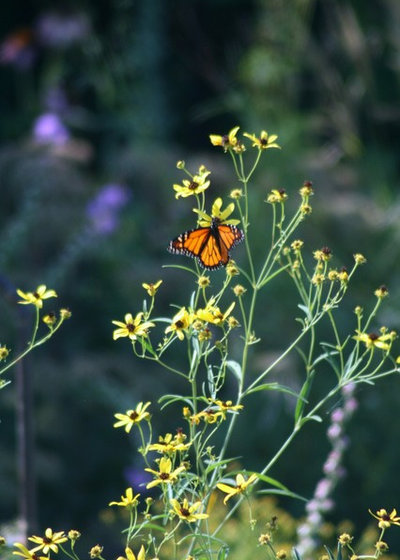
Benjamin Vogt / Monarch Gardens
3. Tall Tickseed(
Coreopsis tripteris)
If you like to look up at your plants, then here’s one for you. Tall tickseed stretches up to 8 feet into the sky. Slowly spreading by runners, which are easily transplanted, it will bloom for several weeks in mid-to-late summer when much has succumbed to the heat. I find that butterflies like to perch on its flowers and stems, and several moth species use it as a host plant.
Where it will grow: Hardy to minus 25 degrees Fahrenheit, or minus 31.7 degrees Celsius (zones 4 to 9)
Origin: Native to areas from the central and southern Great Plains to the Southeast and central East Coast
Water requirement: Dry to moist soil
Light requirement: Full to partial sun
Mature size: 4 to 8 feet tall and wide
See how to grow tall tickseed
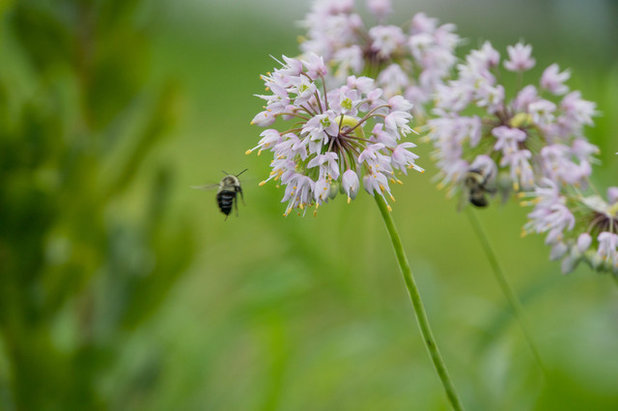 4. Nodding Onion
4. Nodding Onion(
Allium cernuum)
You’ll notice that nodding onion slightly bows its flower heads toward the ground as its blooms mature in summer. Primarily
bumblebees actively forage on this plant’s pollen in mid-to-late summer. Hairstreak butterflies use nodding onion as a larval host plant. Try it in a massed grouping at the front of a border or in a short prairie.
Where it will grow: Hardy to minus 40 degrees Fahrenheit, or minus 40 degrees Celsius (zones 3 to 8)
Origin: Native to the Rocky Mountain states, Washington, Oregon and from Minnesota to Arkansas east from New York to northern Georgia
Water requirement: Medium to moist soil
Light requirement: Full to partial sun
Mature size: 12 to 18 inches tall and wide
See how to grow nodding onion
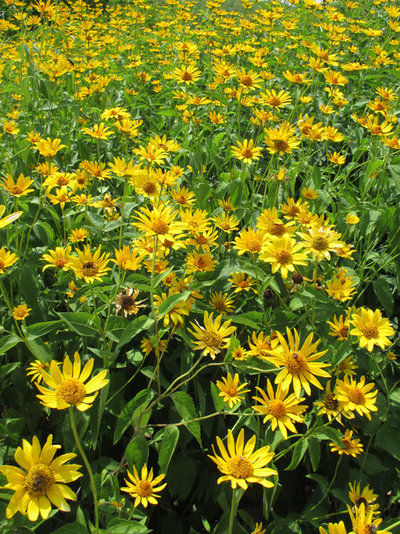
Holm Design & Consulting LLC
5. Smooth Oxeye(
Heliopsis helianthoides)
Smooth oxeye thrives in a range of soils and will work for you if you have a problem area of damp clay. This plant spreads by seeds, not rhizomes, if there is open soil. You’ll see a diversity of pollinators using this plant, so it’s good to have around.
Where it will grow: Hardy to minus 45 degrees Fahrenheit, or minus 42.8 degrees Celsius (zones 2 to 7)
Origin: Eastern North America from North Dakota east to Pennsylvania in the north and New Mexico east to Georgia in the south
Water requirement: Low to medium
Light requirement: Full sun to partial sun
Mature size: About 3 to 5 feet tall and 2 to 4 feet wide
See how to grow smooth oxeye
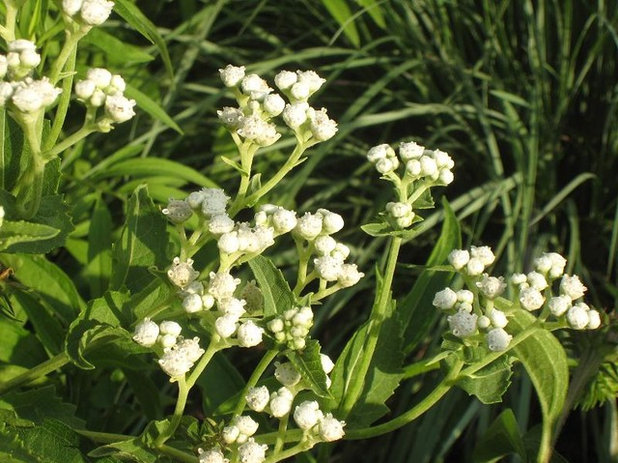
Benjamin Vogt / Monarch Gardens
6. Wild Quinine(
Parthenium integrifolium)
This unusual-blooming native, which resembles mini cauliflower, thrives in slightly moist to slightly dry soil and blooms in early-to-mid summer. Give wild quinine full sun or even half sun in an open woodland setting, and it will be good to go. Herbivores avoid the leaves, which are bitter and like sandpaper.
Where it will grow: Hardy to minus 30 degrees Fahrenheit, or minus 34.4 degrees Celsius (zones 4 to 8
)Origin: Native from Minnesota to Louisiana and reaching toward Appalachia
Water requirement: Medium to dry soil
Light requirement: Full sun to light shade
Mature size: 3 feet tall and 2 to 3 feet wide
See how to grow wild quinine
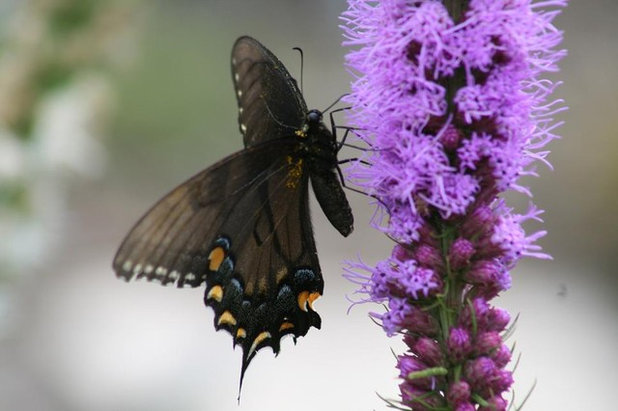
Benjamin Vogt / Monarch Gardens
7. Prairie Blazing Star(
Liatris pycnostachya)
We have many
Liatris species to choose from, but prairie blazing star may be the most commonly sold. Long-tongued bees and butterflies will be the primary visitors as they seek nectar from this midsummer bloomer.
Where it will grow: Hardy to minus 25 degrees Fahrenheit, or minus 31.7 degrees Celsius (zones 4 to 8)
Origin: Native from North Dakota south to Texas and east to Michigan and Mississippi
Water requirement: Low to medium
Light requirement: Full sun
Mature size: 4 to 5 feet tall and 1 foot wide
See how to grow blazing star
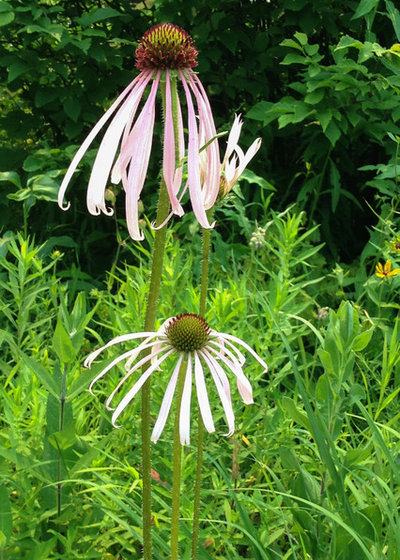
Holm Design & Consulting LLC
8. Pale Purple Coneflower(
Echinacea pallida)
Pale purple coneflower is, perhaps, the easiest coneflower to grow. It is drought-tolerant and blooms before the other coneflowers. In the wild, pale purple coneflower is native to the former tall-grass prairie region. Many types of native bees and butterflies visit its flowers during its early summer bloom.
Where it will grow: Hardy to minus 20 degrees Fahrenheit, or minus 28.9 degrees Celsius (zones 5 to 8)
Origin: Native to central North America, from Iowa south to Texas and east to Indiana in the north and Louisiana in the south
Water requirement: Low to medium
Light requirement: Full sun (but can take a bit of shade)
Mature size: About 3 feet tall and 6 to 12 inches wide at ground level
See how to grow pale purple coneflower
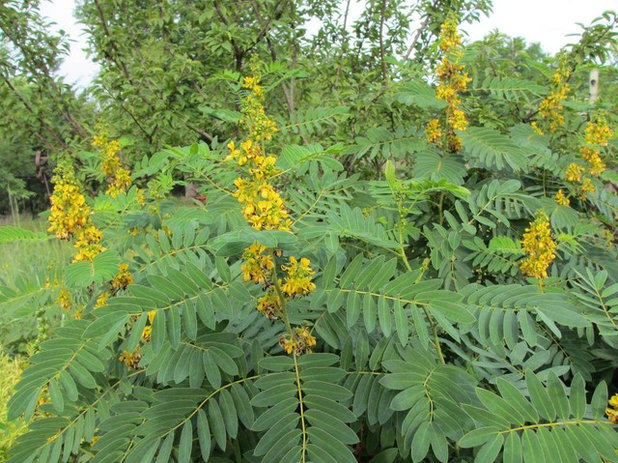
Benjamin Vogt / Monarch Gardens
9. American Senna(
Senna hebecarpa)
You’ll find this shrubby, tropical-looking perennial east of the Mississippi River; its cousin Maryland senna (
Cassia marilandica) reaches farther west from Nebraska to Texas. Give American senna some room, and you’ll enjoy many weeks of mid-to-late summer flowers that bumblebees flock to. American senna is also host to several sulfur butterfly species.
Where it will grow: Hardy to minus 25 degrees Fahrenheit, or minus 31.7 degrees Celsius (zones 4 to 8)
Origin: Native from Wisconsin and Illinois east to southern New England and south to Georgia and Tennessee
Water requirement: Medium to moist
Light requirement: Full to partial sun
Mature size: 4 feet tall and wide
See how to grow American senna





